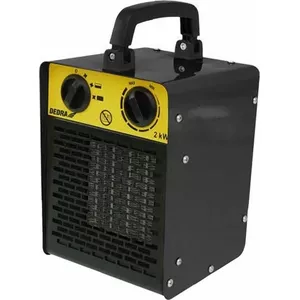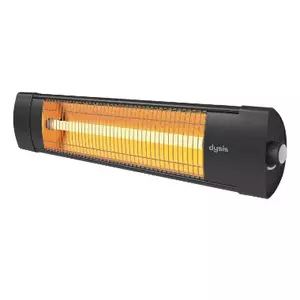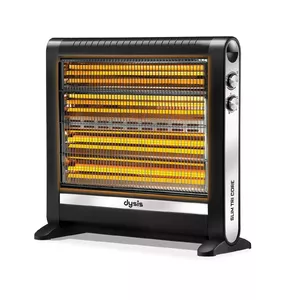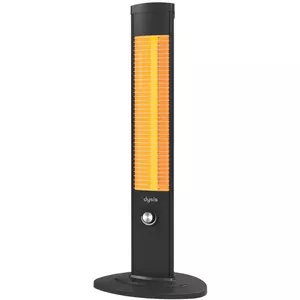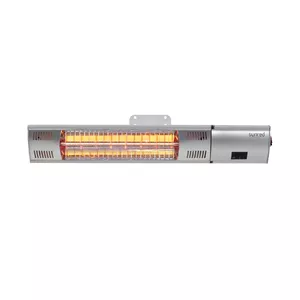more profitable than new ones!
In cart {{totalProductsCount}} item(s)
Your cart is empty
In cart {{totalProductsCount}} item(s)
Your cart is empty
How to choose an electric heater: tips and recommendations
With the approach of the cold winter season and frosts, electric heaters, again, become an important element of any heating system, which ensures a comfortable temperature in your house. But, due to the fact that there are so many different models available on the market, even experienced buyers can get confused. In this article we will look at the main aspects that you should pay attention to if you decide to purchase an electric heater.
What kind of heater to choose?
There are several types of electric heaters: oil, convection, infrared and fan. Each type has its advantages and applications.
Oil heaters
Oil heaters provide a number of advantages that make them a popular choice for space heating:
- Long-term heat retention. Thanks to the oil inside of them, these heaters have high output and retain heat for a very long time even after they are turned off. When the desired temperature is reached, the heater can be turned off. After turning off, its oil will continue to radiate heat, providing uniform heating for some time.
- Does not make the air dry. Unlike some other types of heaters, oil heaters do not dry the air. This is positive for health and comfort, as dry air can irritate the mucous membrane and cause breathing problems.
- Protection. Oil heaters are usually equipped with automatic overheating protection systems. When the heater reaches a certain temperature, it will automatically turn off to prevent overheating. This is an additional layer of safety in case of prolonged use.
- Quiet. Oil heaters work silently as they do not have fans or other moving parts that could make noise. This point is more relevant for those who prefer a calm and quiet atmosphere indoors.
- Universal. Oil heaters are suitable for different types of rooms: from bedrooms to offices. They are able to heat both small and medium sized rooms.
- Economic. In the long run, oil heaters can be more economical than their alternatives, as they are able to retain heat in the room even after they are turned off. This means that the heater can be turned on only when you really need it.
It is important to mention that, like other types of heaters, oil heaters have their own limitations. For example, they take a certain amount of time to warm up, and their maximum power may be limited. However, given all their advantages, oil heaters remain a popular and effective choice for providing comfortable indoor heating.
Convection heaters
Convection heaters, which are also often referred to as "convectors", have a number of advantages that make them an attractive choice for space heating:
- Uniform heating. One of the main advantages of convection heaters is the ability to evenly distribute heat throughout the room. They use the convection principle, which states that the device heats the air which rises up, and then cools again and descends to the ground, creating air circulation. This principle ensures uniform temperature in the room.
- Fast warmup time. The convector heats up very quickly. This allows you to achieve a comfortable room temperature in a short period of time. This is especially useful if you need to quickly warm up the room or if you are temporarily in a cold room.
- Quiet. Convection heaters, as a rule, are not equipped with fans that would make them loud. This point is especially important for those who prefer a calm atmosphere without noise.
- Compactness. Convection heaters, as a rule, have a compact and stylish design that fits into the interior of any room. They take up little space and it is possible to install them on the floor, wall or window sill.
- Efficient power consumption. Thanks to the uniform air circulation, convection heaters can provide efficient use of energy, and maintain a stable temperature in the room.
It is important to mention that convection heaters also have some limitations. They may not be as well suited for long-term heat retention as oil heaters and are not designed for specific locations or places. However, due to their advantages, convection heaters remain a popular choice among users.
Ceramic heaters
A ceramic heater is a type of electric heater that uses ceramic elements to heat the air. It belongs to the category of convection heaters and provides a number of advantages due to its design and technology. The main characteristics and advantages of ceramic heaters:
- Effective warmup. The ceramic element heats up quickly and effectively transfers heat to the surrounding air. This ensures the rapid achievement of a comfortable room temperature and long-term heating.
- Protection. Ceramic heaters, as a rule, have built-in overheating protection systems that, in the event of elevated temperatures, automatically turn off the device, increasing its safety when in use.
- Uniform distribution of heat. Ceramic heaters, like convection alternatives, contribute to the uniform distribution of heat in the room. Fans can be used to increase air circulation and more uniform heating.
- Quiet. The built-in fans of ceramic heaters are usually quiet, creating an environment without unnecessary noise.
- Compact and portable. Ceramic heaters are usually compact in size, making them easy to move from room to room.
- Controllability. Some ceramic heaters are equipped with operating programs or timers that allow you to control the operating time of the device.
- Does not emit any odors. Ceramic heaters, as a rule, do not emit odors, since there is no heating of oil or other substances.
It is important to note that ceramic heaters are more efficient and convenient in small and medium-sized rooms. However, they are less suitable for large rooms.
Infrared heaters
One of the most remarkable advantages of infrared heaters is their ability to instantly warm objects and surfaces instead of air. This means that you will feel the heat almost immediately after turning on the heater. Other advantages of infrared heaters:
- Directed heating. Infrared heaters can direct their rays to specific objects or places in the room. This allows you to effectively heat those places where it is really needed, reducing heat loss.
- Economical. Since infrared heaters heat objects and surfaces, and not the entire surrounding space, they can be more energy efficient than some other types of heaters.
- Preservation of moisture. Infrared heaters do not dry the air in the room, as they do not heat it. It helps to preserve the natural humidity of the air and improves the internal climate.
- Silence. Infrared heaters work silently, as they do not have fans or other moving parts.
- Easy to install and use. Infrared heaters are usually easy to install and do not require complex assembly. They can be hung on the wall, mounted on the ceiling or even placed on the floor.
- No dust. Since infrared heaters do not move air, they can be a good choice for people suffering from allergies, as they do not blow dust and allergens around the room.
It is important to note that infrared heaters may be more suitable for specific situations, for example, local heating of specific areas or objects. They can be especially effective in cold rooms where rapid heating is required.
Fan heaters
One of the main advantages of fan heaters is their ability to quickly heat the air in the room. The built-in fan quickly and evenly distributes warm air, which allows you to achieve your desired temperature in a short time. Fan heaters have gained their popularity due to the following advantages:
- Efficiency in small rooms. Fan heaters are well suited for small rooms, as they are able to quickly and intensively heat an enclosed space.
- Portability. Fan heaters are usually compact and lightweight, making them easy to carry. You can move them from room to room, depending on your heating needs without much effort.
- Optimal heat distribution. The fan creates air circulation, which contributes to the uniform distribution of heat in the room. As well as it allows you to avoid the formation of cold and hot spots in the room.
- Additional ventilation. The fan heater not only heats the air, but can also serve as an additional air fan during the hot seasons. It can be said that this is an all-in-one device for regulating the indoor climate throughout the year.
- Affordable price. Fan heaters often have an affordable price, making them an attractive choice for those who are looking for a budget-friendly heating solution.
It is important to note that fan heaters are usually more efficient in smaller rooms and may not be so well suited for long-term heating of large rooms. They can also create air currents that not all users like. However, due to their advantages, fan heaters remain a popular and convenient choice for fast and efficient heating.
How to determine the required power of an electric heater?
The power of the heater directly affects its ability to heat the room. The calculation of the electric heaters power depends on the size of the room, insulation, climatic conditions and the desired temperature. There is a simple formula for calculating the required power:
Power (W) = room area (m²) × 100 W/m²
This formula assumes that about 100 watts of power will be needed to heat 1 square meter. However, it is worth remembering that this is a general calculation, and the actual capacity may vary.
Remember that there are also a number of factors that can influence this calculation:
- Insulation of the room. If your room is well insulated, you may need less energy to maintain a comfortable temperature. If the insulation is weak, more power may be required.
- Climate. In cold climates, more power will be required to maintain heat.
- Ceiling height. Rooms with high ceilings require more energy for heating.
- The number of windows and doors. Windows and doors can be sources of heat loss, so their quantity and quality of insulation are also important.
- Personal preferences. Some people prefer a colder room temperature, which can also affect the power calculation.
- Work spaces. If the room is used as a kitchen or bathroom, it may require additional power, since these rooms are usually cooled by water and moisture.
- The number of people. A large number of people in the room can create an additional source of heat.
What is an electric heater thermostat and why is it needed?
The thermostat is an important component of heaters, which allows you to set and maintain the optimum temperature. It allows you to save energy and provides you with a comfortable temperature in the room.
Heater safety
When choosing a heater, pay attention to what overheating and overload protection systems it is equipped with. It is also desirable that the heater has protection against accidental overturning.
Additional functions of an electric heater
Modern heaters may have various additional functions, such as timers, remote controls, operating modes (economy, turbo, etc.), the ability to operate the fan without heating.
How to choose a heater. Conclusion
Choosing an electric heater is a crucial step that affects the comfort and heating efficiency of your home or office. When choosing it, consider the type of heater, its power, the presence of a thermostat, safety, portability, additional functions and your own budget. By following these guidelines, you will be able to purchase the perfect heating solution that will meet your needs and create a cozy atmosphere.

